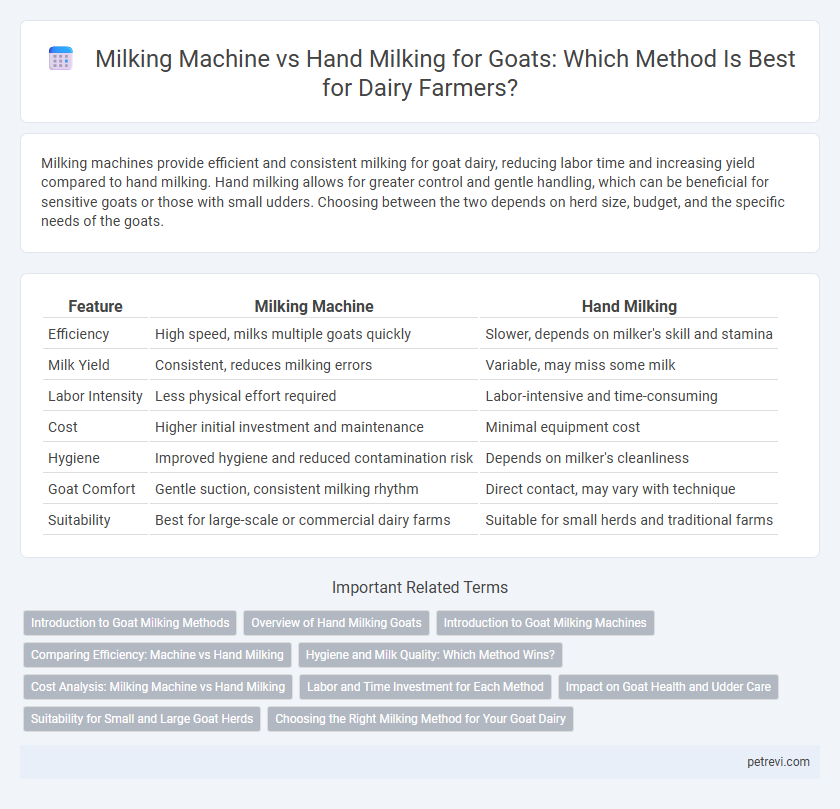Milking machines provide efficient and consistent milking for goat dairy, reducing labor time and increasing yield compared to hand milking. Hand milking allows for greater control and gentle handling, which can be beneficial for sensitive goats or those with small udders. Choosing between the two depends on herd size, budget, and the specific needs of the goats.
Table of Comparison
| Feature | Milking Machine | Hand Milking |
|---|---|---|
| Efficiency | High speed, milks multiple goats quickly | Slower, depends on milker's skill and stamina |
| Milk Yield | Consistent, reduces milking errors | Variable, may miss some milk |
| Labor Intensity | Less physical effort required | Labor-intensive and time-consuming |
| Cost | Higher initial investment and maintenance | Minimal equipment cost |
| Hygiene | Improved hygiene and reduced contamination risk | Depends on milker's cleanliness |
| Goat Comfort | Gentle suction, consistent milking rhythm | Direct contact, may vary with technique |
| Suitability | Best for large-scale or commercial dairy farms | Suitable for small herds and traditional farms |
Introduction to Goat Milking Methods
Goat milking methods primarily include hand milking and using a milking machine, each with distinct operational techniques and benefits. Hand milking offers simplicity and low cost, ideal for small-scale farms, while milking machines enable increased efficiency and hygiene for larger dairy operations. Understanding the advantages and suitability of each method is crucial for optimizing goat milk production and quality.
Overview of Hand Milking Goats
Hand milking goats involves manually extracting milk by gently squeezing the teats, allowing for direct control over the milking process to ensure gentleness and minimize discomfort. It requires skill and regular practice to maintain a consistent and hygienic yield, often preferred in small-scale or traditional dairy operations due to its low cost and minimal equipment needs. This method supports close animal observation, promoting early detection of health issues such as mastitis.
Introduction to Goat Milking Machines
Goat milking machines increase efficiency and hygiene compared to traditional hand milking methods by providing consistent suction that mimics a kid's natural nursing rhythm. These machines reduce labor time and minimize contamination risks, ensuring higher milk quality essential for goat dairy production. Adoption of modern milking equipment supports scalable operations and improves animal welfare through gentle, automated milking.
Comparing Efficiency: Machine vs Hand Milking
Machine milking offers higher efficiency for goat dairy operations, enabling consistent milk extraction at a faster rate compared to hand milking. While hand milking provides a gentle, low-cost method suitable for small-scale farms, it requires more labor and time, reducing overall productivity. Automated milking machines optimize yield and hygiene, significantly benefiting commercial goat dairy producers.
Hygiene and Milk Quality: Which Method Wins?
Milking machines enhance hygiene by minimizing udder contact, reducing bacterial contamination compared to hand milking, which involves direct skin contact and may introduce pathogens if not performed carefully. Milk quality benefits from milking machines due to consistent suction and cleaning cycles that prevent milk degeneration and ensure uniform extraction. Hand milking offers control but carries higher risks of inconsistent hygiene, making milking machines the preferable choice for superior milk safety and quality in goat dairies.
Cost Analysis: Milking Machine vs Hand Milking
Milking machines involve a higher initial investment, often ranging from $500 to $2,000 depending on capacity and features, while hand milking requires minimal startup costs, limited to basic equipment like buckets and stools. Over time, machines can reduce labor costs and increase efficiency, making them cost-effective for larger herds, whereas hand milking remains economically viable for small-scale operations due to low operational expenses. Maintenance and power consumption are ongoing costs with milking machines, contrasting with the purely manual labor of hand milking, emphasizing the need for scale assessment in cost analysis.
Labor and Time Investment for Each Method
Milking machines significantly reduce labor and time investment compared to hand milking, processing multiple goats simultaneously and cutting milking time by up to 50%. Hand milking demands more physical effort, requiring individual attention to each goat and approximately 15-20 minutes per animal. In commercial goat dairies, mechanized milking optimizes efficiency and labor costs, while hand milking remains suitable for small-scale or hobby farms.
Impact on Goat Health and Udder Care
Milking machines, when properly maintained and calibrated, provide consistent pressure that reduces the risk of teat damage and mastitis compared to hand milking, which can vary in technique and pressure. Repeated hand milking might cause uneven stress on the udder, leading to potential soreness or infection, while machines promote uniform stimulation and efficient milk extraction. Ensuring proper hygiene and equipment sterilization is crucial for both methods to maintain optimal goat udder health and overall dairy productivity.
Suitability for Small and Large Goat Herds
Hand milking suits small goat herds due to its low cost and minimal equipment needs, allowing close monitoring of individual goats and maintaining traditional dairy practices. Milking machines offer efficiency and speed optimal for large goat herds, reducing labor time and ensuring consistent milk extraction, which supports higher volume production. For dairy farms scaling up, mechanical milking systems enhance productivity while hand milking remains practical for small-scale or artisanal operations.
Choosing the Right Milking Method for Your Goat Dairy
Choosing the right milking method for your goat dairy involves evaluating factors such as herd size, milk yield, and labor availability. Milking machines offer efficiency and consistency in large-scale operations, reducing milking time and improving hygiene, while hand milking provides greater control and is cost-effective for small herds. Prioritizing animal comfort and milk quality is essential when deciding between mechanized milking and traditional hand milking techniques.
Milking machine vs Hand milking for Goat dairy Infographic

 petrevi.com
petrevi.com